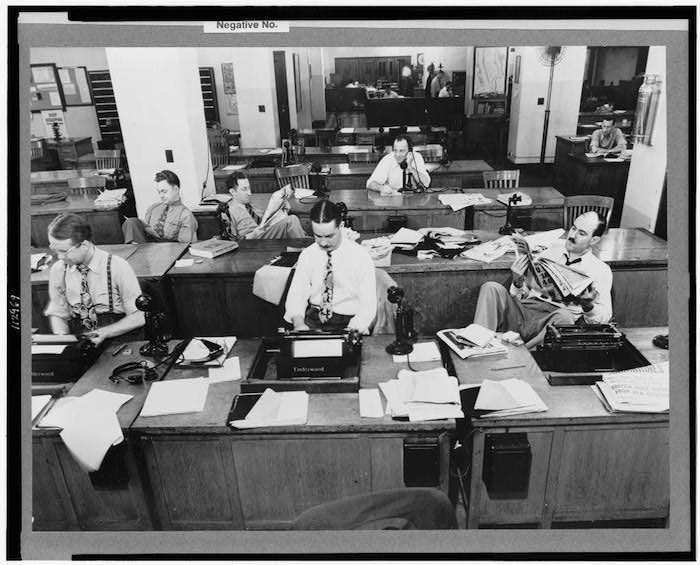
Before joining the faculty of Savannah State University last year to teach multimedia journalism, Jessica Sparks had spent her career working for local, community news organizations like Bluffton Today in Bluffton, S.C. But this summer, Sparks will have the opportunity to work in the newsroom of a slightly larger outlet: The Wall Street Journal.
Sparks is one of five journalism instructors who will have their own internships of sorts as part of the initial class of Back in the Newsroom, a program run by the International Center for Journalists that aims to improve instructors’ digital journalism skills while also fostering diversity in newsrooms. It’s an effort to better align what students are learning and the real-world demands of today’s news business.
“This is a way to keep the professors on the cutting edge of what’s really going on and what the needs are in the newsroom and the technology that’s new in the newsroom really is, ” ICFJ president Joyce Barnathan told me. “Plus, obviously, what they see and what they learn gets transferred into a new and better curriculum.”
The program, which will initially focus on professors from historically black colleges and universities, is funded by a $183,000 grant from the Knight Foundation (disclosure: Knight also supports Nieman Lab), and The Wall Street Journal, USA Today, The Los Angeles Times, CNBC, and The Washington Post are the participating news organizations. The profs will all have a two-day orientation in Washington with ICFJ and then spend about nine weeks this summer in their respective newsrooms, where they will focus on operational areas like multimedia reporting, data-based reporting, social media, and more.
After the professors head back to campus in the fall, ICFJ plans to check in with them periodically to see how they’ve implemented their programs and whether the summer in the newsroom changed their approach toward teaching. With that feedback, ICFJ, Knight, and the participating news organizations will look at whether to continue the program and how to possibly expand it to additional universities and newsrooms while making it self-sustaining.
Raju Narisetti, News Corp’s senior vice president for strategy and an ICFJ board member, was influential in bringing the proposal to Knight; Knight saw Back in the Newsroom as a way to advance its efforts in encouraging newsroom diversity and further its work with historically black colleges and universities, said John Bracken, Knight’s director of journalism and media innovation.“The cutbacks in newsrooms have disproportionately affected minority journalists, and I think African-American journalists even more, so that’s something we’ve been conscious of,” Bracken said. “And second, journalism programs at HBCUs, where we’ve done a little bit of work over the years, have also faced a series of challenges where their faculty are more likely to be overworked and teaching a fuller slate of courses per semester.”
While minorities make up about 37 percent of the U.S. population, only 12.37 percent of the journalists in today’s newspaper newsrooms are racial minorities, according to the American Society of News Editors’ latest survey of newsroom diversity. By focusing the program on historically black schools, the ICFJ and participating news organizations hope they can reach a more diverse pool of aspiring journalists.
And the participating instructors, a number of whom who have not worked in a newsroom for several years, also said that they hope to use their time in the program to gain skills and build relationships that will ultimately help their students.
“My students really deserve the opportunity to show the world that they are not a stereotype,” Sparks said. “Many of them do come from hard situations, so I’d like them to get in an opportunity like an internship at The Wall Street Journal.”
Sparks will work with the Journal’s real-time news desk, “the desk where everything comes together,” said Michelle LaRoche, the Journal’s editor for development. Staffers there write, edit, and publish news for the Journal’s newswires, website, and apps. And she’s not going to be there just to observe, LaRoche said. She’ll be an active member of the team that deals with breaking news on a daily basis.
“It’s going to give her a really good picture of working in a fast-paced, real-time environment in the newsroom,” LaRoche said. “I think that’s the heart of any newsroom now where real-time news is so critical.”
The instructors all stressed the importance of what they’ll be able to take back to their students. Each will have to develop a project during their fellowship that they will then implement in their classrooms when they get back to campus next fall. Morgan State University professor Jerry Bembry, who will work on USA Today’s video team, is still developing his plan, but said he would like it to include his students producing videos that will be published on USA Today’s website.
Similarly, Howard University’s Yolanda McCutchen’s background is in broadcast news, having worked for Dateline before joining the faculty at Howard in 2013 [Update: not 2009 as we originally posted here]. But this summer, she’ll work for The Washington Post, attached to the Post’s video team for half the summer, and she said she hopes to use the experience to demonstrate to her students that there are broadcast opportunities outside of traditional television.
“You may not be breaking in at a news station, but you’re still doing news, but for what used to be a traditional print outlet,” she said.